
| What can this system do? |
| Concepts of "Karton System" | |
It is a simulation system to train for human cataract operations, in which
we make use of butchered pig's eyes that are treated with our "Karton"
agents.
For a brief observation of "Karton System," Click here. |
|
| What agents does Karton system consist of? |
| ★ Three types of Karton agents | |
Karton consist of three types of chemical agents, namely "Karton-C
I," "-C II," and "-N," bottled in individual containers.
Note that what we call "Karton-C" is a mixture of "-C
I" and "-C II," which are to be mixed just before you begin
your practice. As you can see in the photos below, it begins to gel right away after mixing.
|
|
| Karton - C I |
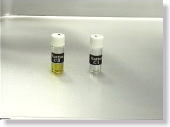 |
|
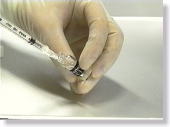 |
| The clear, glutinous agent on the right, containing 1.2 ml. |
|
| Karton - C II |
 |
|
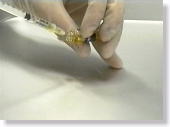 |
| The yellow, smooth agent on the left, containing 0.7ml. |
|
| Karton - N |
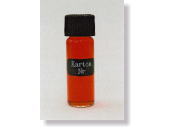 |
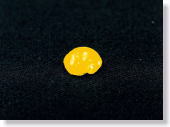 |
| The vermilion, slightly glutinous agent, containing 2.5 ml. |
|
|
| What is "C" used for? |
| ★ Karton "C" | |
● Objectives:
It is used for the practice of anterior capsulorhexis in a simulated PEA operation (phacoemulsification and aspiration operation)
on cataract models of various consistencies.
|
● Overall Steps of procedures:
Insert a needle from the posterior capsule of a butchered pig's eye and
inject a dose of Karton-C, a gelation agent, right under the anterior capsule.
⇒ Wait till the nucleus opacifies. ⇒ Practice performing a CCC
on the chemically degenerated pig's eye with a cystotome and/or capsulorhexis
forceps.
|
|
● How to use "Karton-C":
Draw in 0.2 ml of "Karton-CI" and 0.1 ml of "Karton-CII"
into a syringe just before the practice, which mixture is to be used as
a compound agent, "Karton-C."
|
 |
|
 |
| "Karton-CI" |
|
"Karton-CII |
|
Firstly, make a side port about the equator of sclera with a stab knife
or a slit knife, insert a blunt needle of a syringe filled with "Karton-C"
through the scleral side port into the eye ball. Steadily advance
toward the posterior pole of the posterior capsule. After piercing
into the posterior capsule, advance the needle until it is right under
the center of the anterior capsule. Then inject the agent into the
center area of pupil spreading in a round shape.
|
|
The "Karton-C" injected beneath the anterior capsule will begin
to harden immediately. Within a few minutes, it will be in a state
appropriate for the practice of a soft nucleus cataract or a hyper mature
cataract. Within 15 minutes or so, the solidity will approximate
that of a mature human cataract.
|

|
To obtain further information,
click "Detailed Information of Karton-C"
|
| |
| What is "N" used for? |
| ★ Karton "N" | |
● Objectives:
It is used for the practice of PEA operations on cataract models of various consistencies.
|
● The flow of procedures:
Perform a CCC on the anterior capsule of a butchered pig's eye. ⇒ Remove
the soft contents in the bag with a PEA machine. ⇒ Slowly inject "Karton-N"
as a substitute for the viscoelastic material in the same manner as in
implantation of IOL ⇒ Wait over for 10 minutes till an artificial nucleus
gels. ⇒ Then it is ready for your practice as a model for a human cataract
nucleus.
|
|
● How to use "Karton-N":
Apply viscoelastic material (drawing a circle) onto the upper side of the
iris after CCC. ⇒ When the capsular bag is intact, insert a blunt needle
filled with "Karton-N" through the corneal side port into the
capsular bag and inject "Karton-N" slowly under the anterior
capsule of the bag. ⇒ Let it sit till the agent gels.
|

|
If you let it sit for over 10 minutes, you can produce a cataract model
of high solidity.
To obtain further information,
click "Detailed Information of Karton-N"
|
|
◆ Handling & Preserving Cautions ◆
●Karton agents are safe on your hands or tissues during experiments. The
ingredients are gel chemicals whose composition is mainly polyvalent alcohol
that reacts with water and hardens. They are, however, inflammable,
so restrain from smoking during experiments and also keep away from the
fire devices.
●Since Kartons are gelation agents, they may gel and harden in the containers
depending on how they are preserved. However, they are not inferior.
When the agent is found hard inside the container, either shake or
warm up the bottle. If it is still hard, then stir up the contents.
Generally, they are apt to harden in low temperature. Please
contact JACRS Ltd. for questions or deficiency of the products. Thank you. | |
|